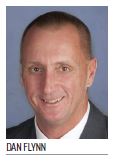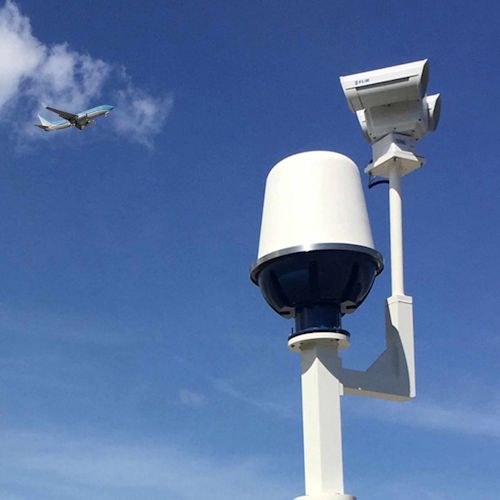When you think of cities with large high-tech and engineering sectors, you probably think of San Jose, CA. Or Austin, TX. Or maybe even Huntsville, AL. But Melbourne, FL, is a powerhouse of its own, with key facilities for Northrop Grumman, Rockwell Collins, L3, General Dynamics, Thales, Embraer Executive Jets, and the world headquarters of Harris Corp.
When you think of cities with large high-tech and engineering sectors, you probably think of San Jose, CA. Or Austin, TX. Or maybe even Huntsville, AL. But Melbourne, FL, is a powerhouse of its own, with key facilities for Northrop Grumman, Rockwell Collins, L3, General Dynamics, Thales, Embraer Executive Jets, and the world headquarters of Harris Corp.
 “If you look around our airfield, we’re surrounded by high-tech titans,” says Greg Donovan, executive director of Orlando Melbourne International Airport (MLB). “We embrace it.”
“If you look around our airfield, we’re surrounded by high-tech titans,” says Greg Donovan, executive director of Orlando Melbourne International Airport (MLB). “We embrace it.”
Kennedy Space Center is a short drive up the sparkling Space Coast from MLB, and many of the components for NASA’s rockets are created and manufactured in the area. “My next-door neighbor is, quite literally, a rocket scientist,” says Lori Booker, the airport’s director of communications.
|
Project: Situational Awareness & Security System Location: Orlando Melbourne (FL) Int’l Airport Timeline: System delivered & installed in June 2017; airport began using it in Sept. 2017 Prime Equipment & Software Vendor: Harris Corp. Radar System Subcontractor: Security Radar Integrators Est. Total System Cost: About $1 million (over 5-yr period) for airports with similar requirements System Components: 2 Symphony Airfield Radar System units; license for AdvanceGuard ARS Software; Symphony ADS-B Xtend unit; 5 Symphony Vehicle Movement Area Transponders; 5 Symphony MobileVue Real-time Situational Awareness Software Licenses; license for Harris NextGen Surveillance Data; hardware/software warranty, maintenance & support Key Benefits: Tracking ground support vehicles & aircraft on ground; improved perimeter security/wildlife management |
A new system developed by Harris, one of MLB’s high-tech neighbors, is helping improve situational awareness at the airport by tracking the ground movement of aircraft and ground support vehicles. It also enhances security by alerting personnel about incursions from wildlife and other unwanted intruders.
Neighborly Gesture
A few years ago, Harris Corp. approached MLB with an idea for a pilot program. “We were looking for ways to design our products to serve non-hub airports,” explains Chris Zanardi, the company’s general manager of Harris’ Symphony commercial aviation solutions business unit. “We wanted to find a way to help the airport in Melbourne support their growth and give them affordable ways to acquire new technology.”
The system Harris eventually proposed included a partnership with Security Radar Integrators (SRI). The company’s Airfield Radar System (ARS) automates surveillance over much of MLB’s airfield to monitor surface movement, provide perimeter security and detect wildlife issues.
“Because of ARS’ high resolution, object classification and user-defined rules, detection rates approach 100% and false alarms approach 0%,” reports Dan Flynn, SRI founder and president.
Flynn spent several years at Honeywell, deploying 20 radar sites around the world for airports, seaports, industrial plants and offshore platforms. To date, his company has conducted more than 10 field trials at U.S. commercial airports. Evaluated for the FAA by National Safe Skies Alliance at several U.S. airports, the ARS radar operates at 30 European airports and is now available in the United States, thanks to an FCC ruling finalized in 2017 allowing the ARS frequency with no license required. Because the ruling is so new, SRI has a considerable head start on competitors.
 While traditional systems use transponders to keep track of aircraft on airfields, ARS tracks everything, whether it has a transponder or not, says Flynn. Although most aircraft have transponders, some small planes may not; and sometimes pilots don’t turn their transponders on, which usually make them difficult to track. If a plane goes out of the aircraft movement area—to park overnight, for instance—it also may not be found by other systems. Aircraft personnel are instructed to turn off their transponders outside of set areas to avoid creating extra radio “noise.”
While traditional systems use transponders to keep track of aircraft on airfields, ARS tracks everything, whether it has a transponder or not, says Flynn. Although most aircraft have transponders, some small planes may not; and sometimes pilots don’t turn their transponders on, which usually make them difficult to track. If a plane goes out of the aircraft movement area—to park overnight, for instance—it also may not be found by other systems. Aircraft personnel are instructed to turn off their transponders outside of set areas to avoid creating extra radio “noise.”
“What attracted us to this program is that it could serve two functions: operations and security,” says Zanardi. “Many security systems are fence-based and only look at the fence for surveillance. Our 360-degree system can look at the whole airfield. It’s a security system for the whole airfield, not just the perimeter.”
MLB also uses the radar system for wildlife management. “The system will detect wildlife, and it alerts us to potential problems in real time,” says Donovan. “We’re in Florida—wildlife abounds. We take special pride in the fact that we have designed our airfield to avoid wildlife, and the system Harris and SRI have designed allows us to take the next step to keep our guests, and the wildlife, safe.”
ASDE-X Alternative
ASDE-X Model X (ASDE-X) is a surveillance system that uses radar, satellite technology and multilateration (a surveillance technique based on the measurement of the difference in distance to two stations at known locations by broadcast signals at known times). The mix of technologies allows air traffic controllers to track the surface movement of aircraft and vehicles on runways and taxiways, and was developed to help reduce critical Category A and B runway incursions. By collecting data from a variety of sensors, ASDE-X is able to track aircraft and vehicles in airport movement areas—whether or not they are equipped with transponders.
 “By itself, SRI’s radar system is very useful; but combined with Harris Symphony, it’s a mini ASDE-X,” says Zanardi. “The collaboration between Harris and SRI provides almost the same level of situational awareness capability as what an ASDE-X would provide.”
“By itself, SRI’s radar system is very useful; but combined with Harris Symphony, it’s a mini ASDE-X,” says Zanardi. “The collaboration between Harris and SRI provides almost the same level of situational awareness capability as what an ASDE-X would provide.”
SRI’s services were a natural extension to Harris’ portfolio, because they have a commercial data feed called “NextGen Data,” into which all the FAA surveillance data is integrated, Zanardi explains. For non-ADS-B vehicles and aircraft, the system at MLB picks up the ARS radar data on the surface and fuses that with their existing track from the NextGen Data. Aircraft can then be tracked all the way across the airfield.
“ASDE-X typically tracks all aircraft transponding their identification information or tail numbers,” says Zanardi. “With the ARS alone, you don’t have that same identification information. The ARS identifies each aircraft as a target on the surface, and once integrated with our NextGen Data we are able to properly match the ARS track with the FAA aircraft tail number for that specific operation. This system only needs two ARS sensors.”
“With the integration of Harris’ NextGen and ARS data we maintain the aircraft identifier—that’s where the science comes into play,” says Zanardi. “MLB is one of the first to fuse its ARS data with NextGen data.”

In addition to the ARS, the airport’s system includes an ADS-B Xtend, which allows it to track ADS-B equipped aircraft all the way to the gate.
Tracking Vehicles
MLB is the first non-ASDE-X or non-ASSC U.S. airport to use VMAT (Vehicle Movement Area Transponder) units to track its surface vehicles. Currently, only ASDE-X or ASSC airports are eligible for FAA Airport Improvement Program funds. Surveillance data for vehicles equipped with VMAT units are fully integrated with the National Airspace System to make movement area ground operations safer and more efficient. VMAT is compatible with the FAA’s Next Generation surveillance technology, ADS-B.
“All this integrated NextGen, ADS-B XTend, ARS and VMAT surveillance data is brought into our back-end system and displayed on the MobileVue app for the airport,” says Zanardi. “Personnel can log in and see the full surveillance system on one interface, which displays the integrated data from both SRI and Harris.”
What Other Airports Should Know
One thing to keep in mind is that radar systems use line-of sight sensors, and airports often have buildings that affect line-of-sight requirements. In such cases, Flynn notes that shorter range ARS units can fill the gaps, or long-range units can be used to create a virtual barrier between the buildings and critical areas.
More cameras aren’t necessarily the solution. “A long-range 360-degree radar is much more effective than cameras for detection”, he advises. “With cameras, there is a tradeoff between range and field of view. Radar, on the other hand, offers long range over 360 degrees.”
The solution MLB chose was to place cameras around the airfield and zoom in as indicated by the radar, creating a system to cover all the bases. And the software can “learn.” The rules-based system classifies objects it detects as people, vehicles and aircraft, and also recognizes exceptions. For instance, the airport may set up a rule to advise that autos on the surface roads are allowed, but people are not. Moreover, a rule can be set to alert security personnel if a person climbs over the perimeter fence.
 The preponderance of data the system generates proved to be a mixed blessing for MLB. “In the compilation of data, there was so much that had never been at our fingertips before,” says Donovan. “The enormity of the data and how to read it and apply it was something new. From a user standpoint, we didn’t have to look at 20 different things anymore.”
The preponderance of data the system generates proved to be a mixed blessing for MLB. “In the compilation of data, there was so much that had never been at our fingertips before,” says Donovan. “The enormity of the data and how to read it and apply it was something new. From a user standpoint, we didn’t have to look at 20 different things anymore.”
Flynn recommends a phased approach for airports considering a similar solution: “If your priority is security at the gates, or tracking vehicles, take a look at the data that can best meet those needs. Understand your business and the priorities, and phase-in different capabilities.”
Beyond Security
In September, MLB landed its largest FAA grant ever: $18.1 million to upgrade the airport’s longest runway, 9R-27L. Total funding, just north of $20 million, will be used for a runway lighting project and the design/construction of a mill and overlay project for the 10,181-foot runway. An additional $5 million in funding will be used to rehabilitate the airport’s other two runways. MLB’s Runway 9L-27R rehabilitation project was recently completed, and Runway 5-23 construction is currently underway. The runway projects, upgrades within the terminal and its new security/situational awareness system are all helping MLB gear up for future growth. Passenger numbers for February 2017 alone rose 3.6%.
Airport marketing personnel note that MLB is one of the least expensive airports in Florida from an airline cost perspective. And although it competes with nearby airports for passengers, the overall growth of Florida tourism has provided plenty of customers to go around in recent years.


 facts&figures
facts&figures

